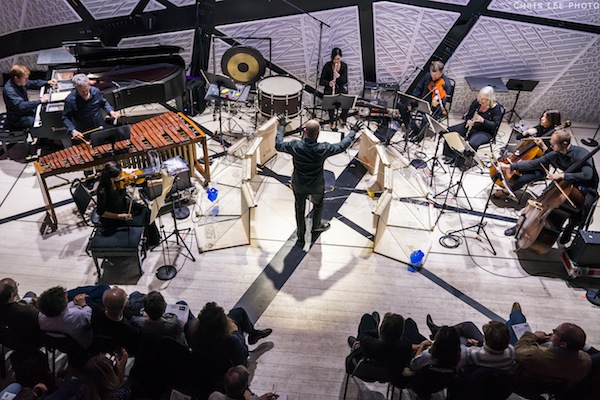From iconoclastic to inane, music of young Russians wraps CONTACT! series

A plugged-in Jeffrey Milarsky conducted Alexander Khubeev’s “Ghost of Dystopia” at Monday night’s CONTACT! program at National Sawdust. Photo: Chris Lee
The convergence of setting and occasion was almost too perfect Monday night at National Sawdust, a Brooklyn arts space in the hipster redoubt of Williamsburg. Inside a vaulting, geometric concert hall that looks like a Soviet-era Suprematist box, a new-music chamber program showcasing edgy young Russian composers presented examples of iconoclasm at its most powerful and its most inane.
This was the season’s final installment of CONTACT!, the New York Philharmonic’s boundary-pushing series presented in conjunction with National Sawdust. The Philharmonic ranks provided most of the personnel for the evening’s five works, four of them U.S. premieres. The host Monday was a charming and sometimes bemused-sounding Esa-Pekka Salonen, the orchestra’s current composer in residence.
“Welcome to this night of dystopia, pain and nostalgia,” Salonen said by way of greetings, offering both intended and (possibly) unintended framing of the work to come.
The New Russians on display Monday night do sound a little nostalgic, perhaps for an era when avant-garde classical held more promise as a great, humanist undertaking against the forces of dystopia. But their strongest impulse, based on Monday’s selections, seems to be to just put themselves out there on the line between groundbreaking and ridiculous, and see what develops.
The best of the lot belonged to Marina Khorkova. A Russian-born, Berlin-based composer, her VORderGRENZE (2010) — loosely translated as “Near the Border” — was heard in its U.S. premiere. Described by Khorkova in program notes as a contemplation of dying and “the struggle for the final breath,” the piece opened with a low shriek from Meighan Stoops’s bass clarinet. From there, it proceeded absorbingly through a kind of collective breathing, with a trio instrumental voices alternately merging and splintering.
Eric Huebner, playing prepared piano, stood over his instrument and extracted eerie tones from its keys and muted strings. Sumire Kudo, the cellist, emitted an unearthly crunch by grinding her bow against the instrument’s back. Ultimately, Khorkova’s work struck a discerning balance between abstraction and compassion. The only debatable element in VORderGRENZE was the use of megaphones. Each instrumentalist picked one up at odd intervals in order to project actual breathing noises. Maybe this was Khorkova introducing a dash of absurdism, but the sight of musicians exhaling through large white cones seemed too literal-minded.
If VORderGRENZE was orchestration simulating breath, Voice-off (2008) by Dmitri Kourliandski was its inverse: the use of vocalization to approximate an ensemble. Guest vocalist Ethan Hayden, working alone with a microphone, performed this challenging oddity to open the concert’s second half, and his triumph was in completing Kourliandski’s relentless oral assault — a fusillade of wet, percussive slaps, grunts, clicks, pops and sustained notes produced with tongue, cheeks, lips, teeth, throat and what had to be peerless breath control.
Voice-off — the only piece not having its U.S. premiere — lasted more than 10 minutes, with few pauses, and some sections in which Hayden, remarkably, produced lengthy notes and percolating noises simultaneously. More than hip-hop’s “beat-boxing” turntable simulations, or rock singer Mike Patton’s experimental 1996 album, Adult Themes for Voice (for John Zorn’s Tzadik label), Voice-off was an undeniable feat of endurance, technical virtuosity, and compositional imagination. But its unavoidable resemblance to loudly chewed food won’t necessarily recommend second helpings.
“I’ve seen thousand of scores,” Salonen said afterward, “but this is the only one with a separate staff for the Adam’s apple.”
Two other pieces were more conventionally orchestrated, at least by comparison. The evening’s opener, Nibiru 20/13 (2013) by Nikolay Popov, employed pre-recorded sounds and abstract visual projections on the wall behind a string quintet: violinists Anna Rabinova and Marié Rossano, violist Peter Kenote, cellist Wendy Sutter, and bassist Max Zeugner. The vigorous, bracing volleys between strings and artificial sounds, human and machine, recalled the old psychoacoustic adventures of composer Mario Davidovksy’s Synchronisms series, but compositionally, Popov didn’t advance them much further beyond replacing reel-to-reel tape with laptop.
Barcarolle (2016), by Denis Khorov, was the most traditionally classical piece of the five. A variation on the titled Italian song style, Khorov’s Barcarolle begins awkwardly, treading forward as if on pins and needles. That feeling of tentativeness in the composition was magnified Monday by the quartet — Stoops, Kudo, Huebner and flutist Yoobin Son — struggling at first to find a common pitch. But the piece and the ensemble both settled in, and Barcarolle really found its footing with some nimble two-step sequences between cello and piano.
Salonen introduced the evening’s finale, Ghost of Dystopia (2014) by Alexander Khubeev, as “a conducting doomsday machine.” Indeed, guest conductor Jeffrey Milarsky looked as if he were being prepared for execution — fitted with black gloves whose fingers were attached to strings that were in turn attached to noisemaking devices. These plastic vessels, sliding up and down a set of acrylic panels arranged in a rough circle around the conductor, are referred to by the composer as “acoustic sensors” — a whimsical play on the motion-detecting, sound-generating electronic devices that have gained currency with some composers.
Four more of them were also clipped to Milarsky’s elbows and knees, almost freezing him in place. Lashed to his cobbled instrument, with his back to the audience, Milarsky bent and gestured like a rusty marionette, producing the white-noise cues that yielded Dystopia’s clanking, scraping, accumulating racket. (“For once, the conductor is doing something useful,” Salonen joked beforehand.)
Milarsky followed the score on a digital screen. And there was enough structure to Khubeev’s piece to justify a score, along with instrumental flares recalling the improvisations of Sun Ra, and inventive sound-making by players including percussionist Daniel Druckman. But Ghost of Dystopia ultimately came off as indulgent nonsense. Salonen proclaimed it “the end of music as we know it, and the beginning of something new.” It was something, alright.






